Analysis of Funding Options for Expedia's Global Expansion Plan
VerifiedAdded on 2021/04/21
|13
|3071
|40
Report
AI Summary
This report examines the funding strategies for Expedia's expansion plan within the travel and tourism industry. It begins with an introduction to the industry and Expedia, outlining the company's objectives and market analysis. The report then delves into various relevant sources of finance, including home equity loans, leverage in retirement funds, Small Business Association (SBA) loans, funding from friends and family, and partnerships, detailing the advantages and disadvantages of each. It further explores the expected costs and benefits associated with the expansion, particularly focusing on sustainable tourism initiatives and the impact on marketing strategies. The report also discusses pricing strategies in the competitive travel market, concluding with an analysis of the financial implications and growth potential for Expedia. The report also uses the cost volume profit analysis to showcase the level of sales required at which cost and revenue would be in equilibrium position.
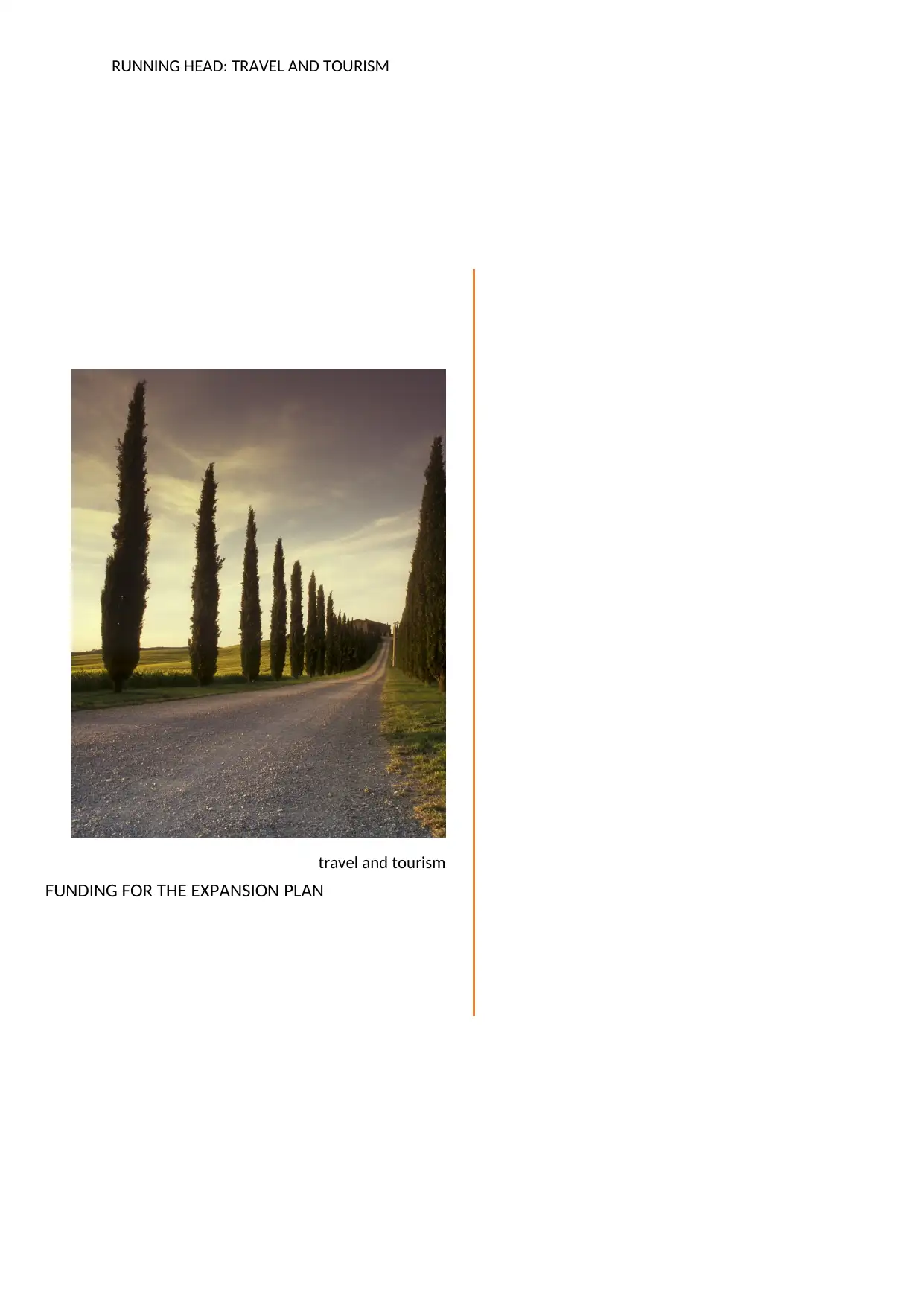
RUNNING HEAD: TRAVEL AND TOURISM
travel and tourism
FUNDING FOR THE EXPANSION PLAN
travel and tourism
FUNDING FOR THE EXPANSION PLAN
Paraphrase This Document
Need a fresh take? Get an instant paraphrase of this document with our AI Paraphraser
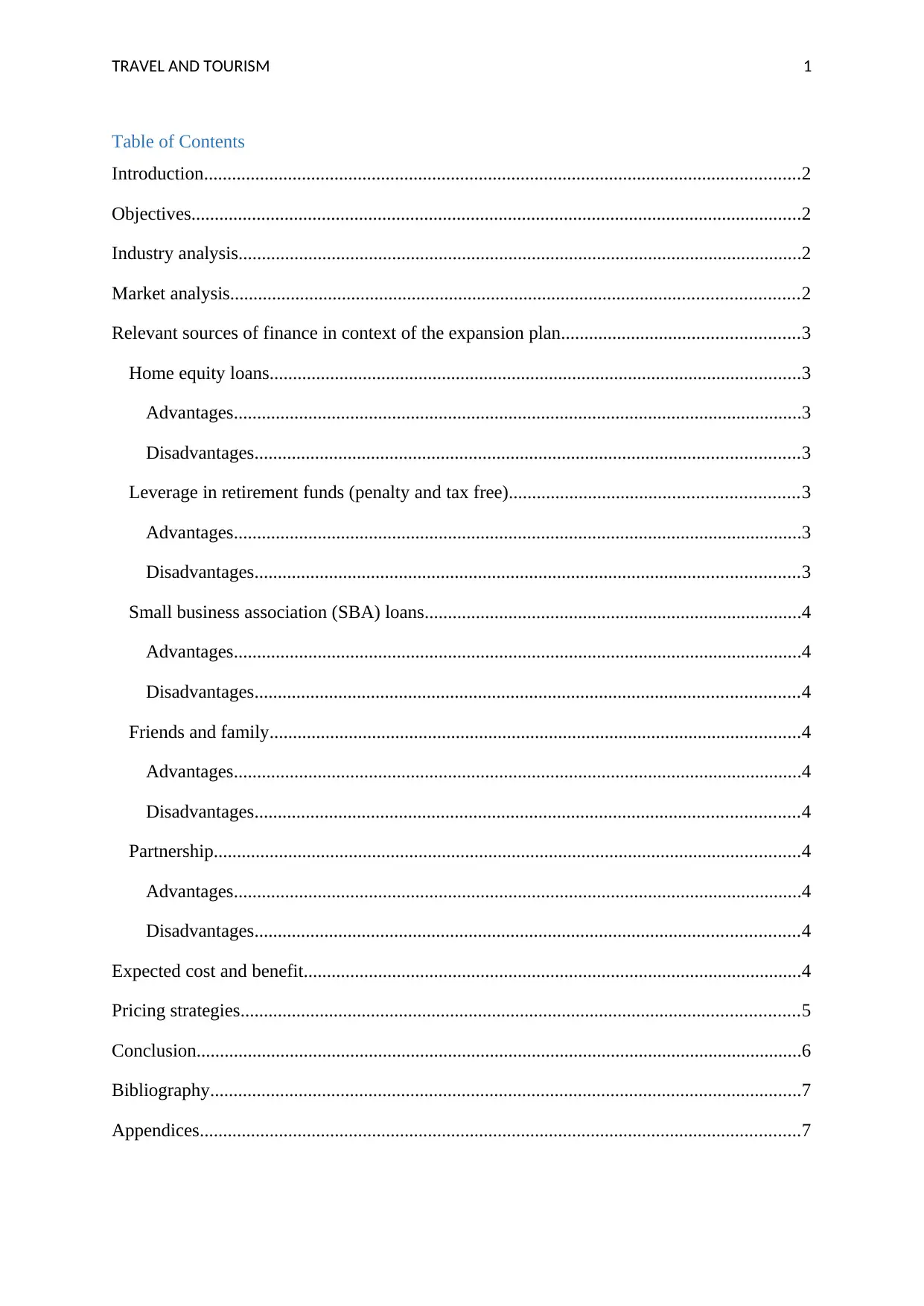
TRAVEL AND TOURISM 1
Table of Contents
Introduction................................................................................................................................2
Objectives...................................................................................................................................2
Industry analysis.........................................................................................................................2
Market analysis..........................................................................................................................2
Relevant sources of finance in context of the expansion plan...................................................3
Home equity loans..................................................................................................................3
Advantages..........................................................................................................................3
Disadvantages.....................................................................................................................3
Leverage in retirement funds (penalty and tax free)..............................................................3
Advantages..........................................................................................................................3
Disadvantages.....................................................................................................................3
Small business association (SBA) loans.................................................................................4
Advantages..........................................................................................................................4
Disadvantages.....................................................................................................................4
Friends and family..................................................................................................................4
Advantages..........................................................................................................................4
Disadvantages.....................................................................................................................4
Partnership..............................................................................................................................4
Advantages..........................................................................................................................4
Disadvantages.....................................................................................................................4
Expected cost and benefit...........................................................................................................4
Pricing strategies........................................................................................................................5
Conclusion..................................................................................................................................6
Bibliography...............................................................................................................................7
Appendices.................................................................................................................................7
Table of Contents
Introduction................................................................................................................................2
Objectives...................................................................................................................................2
Industry analysis.........................................................................................................................2
Market analysis..........................................................................................................................2
Relevant sources of finance in context of the expansion plan...................................................3
Home equity loans..................................................................................................................3
Advantages..........................................................................................................................3
Disadvantages.....................................................................................................................3
Leverage in retirement funds (penalty and tax free)..............................................................3
Advantages..........................................................................................................................3
Disadvantages.....................................................................................................................3
Small business association (SBA) loans.................................................................................4
Advantages..........................................................................................................................4
Disadvantages.....................................................................................................................4
Friends and family..................................................................................................................4
Advantages..........................................................................................................................4
Disadvantages.....................................................................................................................4
Partnership..............................................................................................................................4
Advantages..........................................................................................................................4
Disadvantages.....................................................................................................................4
Expected cost and benefit...........................................................................................................4
Pricing strategies........................................................................................................................5
Conclusion..................................................................................................................................6
Bibliography...............................................................................................................................7
Appendices.................................................................................................................................7
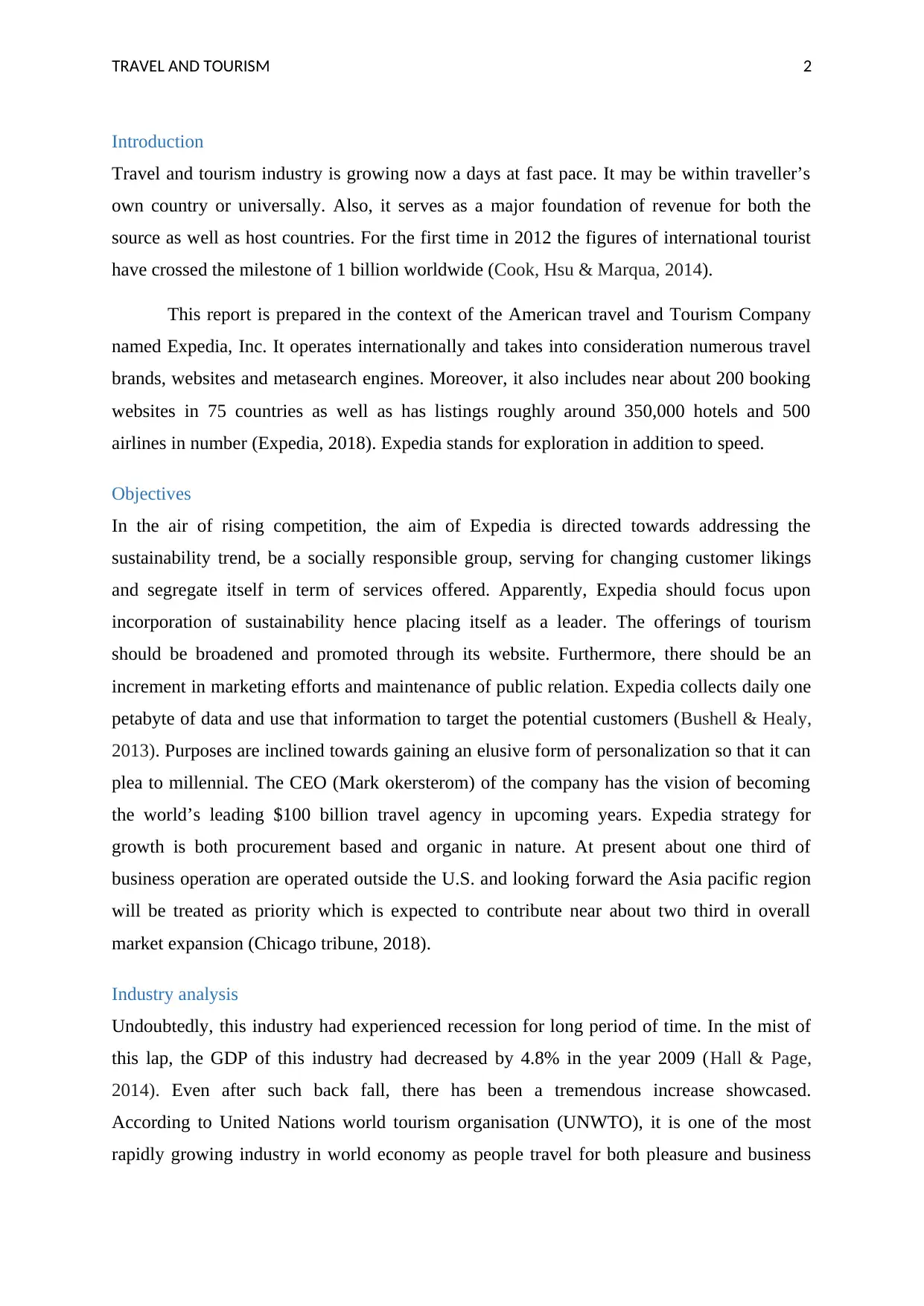
TRAVEL AND TOURISM 2
Introduction
Travel and tourism industry is growing now a days at fast pace. It may be within traveller’s
own country or universally. Also, it serves as a major foundation of revenue for both the
source as well as host countries. For the first time in 2012 the figures of international tourist
have crossed the milestone of 1 billion worldwide (Cook, Hsu & Marqua, 2014).
This report is prepared in the context of the American travel and Tourism Company
named Expedia, Inc. It operates internationally and takes into consideration numerous travel
brands, websites and metasearch engines. Moreover, it also includes near about 200 booking
websites in 75 countries as well as has listings roughly around 350,000 hotels and 500
airlines in number (Expedia, 2018). Expedia stands for exploration in addition to speed.
Objectives
In the air of rising competition, the aim of Expedia is directed towards addressing the
sustainability trend, be a socially responsible group, serving for changing customer likings
and segregate itself in term of services offered. Apparently, Expedia should focus upon
incorporation of sustainability hence placing itself as a leader. The offerings of tourism
should be broadened and promoted through its website. Furthermore, there should be an
increment in marketing efforts and maintenance of public relation. Expedia collects daily one
petabyte of data and use that information to target the potential customers (Bushell & Healy,
2013). Purposes are inclined towards gaining an elusive form of personalization so that it can
plea to millennial. The CEO (Mark okersterom) of the company has the vision of becoming
the world’s leading $100 billion travel agency in upcoming years. Expedia strategy for
growth is both procurement based and organic in nature. At present about one third of
business operation are operated outside the U.S. and looking forward the Asia pacific region
will be treated as priority which is expected to contribute near about two third in overall
market expansion (Chicago tribune, 2018).
Industry analysis
Undoubtedly, this industry had experienced recession for long period of time. In the mist of
this lap, the GDP of this industry had decreased by 4.8% in the year 2009 (Hall & Page,
2014). Even after such back fall, there has been a tremendous increase showcased.
According to United Nations world tourism organisation (UNWTO), it is one of the most
rapidly growing industry in world economy as people travel for both pleasure and business
Introduction
Travel and tourism industry is growing now a days at fast pace. It may be within traveller’s
own country or universally. Also, it serves as a major foundation of revenue for both the
source as well as host countries. For the first time in 2012 the figures of international tourist
have crossed the milestone of 1 billion worldwide (Cook, Hsu & Marqua, 2014).
This report is prepared in the context of the American travel and Tourism Company
named Expedia, Inc. It operates internationally and takes into consideration numerous travel
brands, websites and metasearch engines. Moreover, it also includes near about 200 booking
websites in 75 countries as well as has listings roughly around 350,000 hotels and 500
airlines in number (Expedia, 2018). Expedia stands for exploration in addition to speed.
Objectives
In the air of rising competition, the aim of Expedia is directed towards addressing the
sustainability trend, be a socially responsible group, serving for changing customer likings
and segregate itself in term of services offered. Apparently, Expedia should focus upon
incorporation of sustainability hence placing itself as a leader. The offerings of tourism
should be broadened and promoted through its website. Furthermore, there should be an
increment in marketing efforts and maintenance of public relation. Expedia collects daily one
petabyte of data and use that information to target the potential customers (Bushell & Healy,
2013). Purposes are inclined towards gaining an elusive form of personalization so that it can
plea to millennial. The CEO (Mark okersterom) of the company has the vision of becoming
the world’s leading $100 billion travel agency in upcoming years. Expedia strategy for
growth is both procurement based and organic in nature. At present about one third of
business operation are operated outside the U.S. and looking forward the Asia pacific region
will be treated as priority which is expected to contribute near about two third in overall
market expansion (Chicago tribune, 2018).
Industry analysis
Undoubtedly, this industry had experienced recession for long period of time. In the mist of
this lap, the GDP of this industry had decreased by 4.8% in the year 2009 (Hall & Page,
2014). Even after such back fall, there has been a tremendous increase showcased.
According to United Nations world tourism organisation (UNWTO), it is one of the most
rapidly growing industry in world economy as people travel for both pleasure and business
⊘ This is a preview!⊘
Do you want full access?
Subscribe today to unlock all pages.

Trusted by 1+ million students worldwide
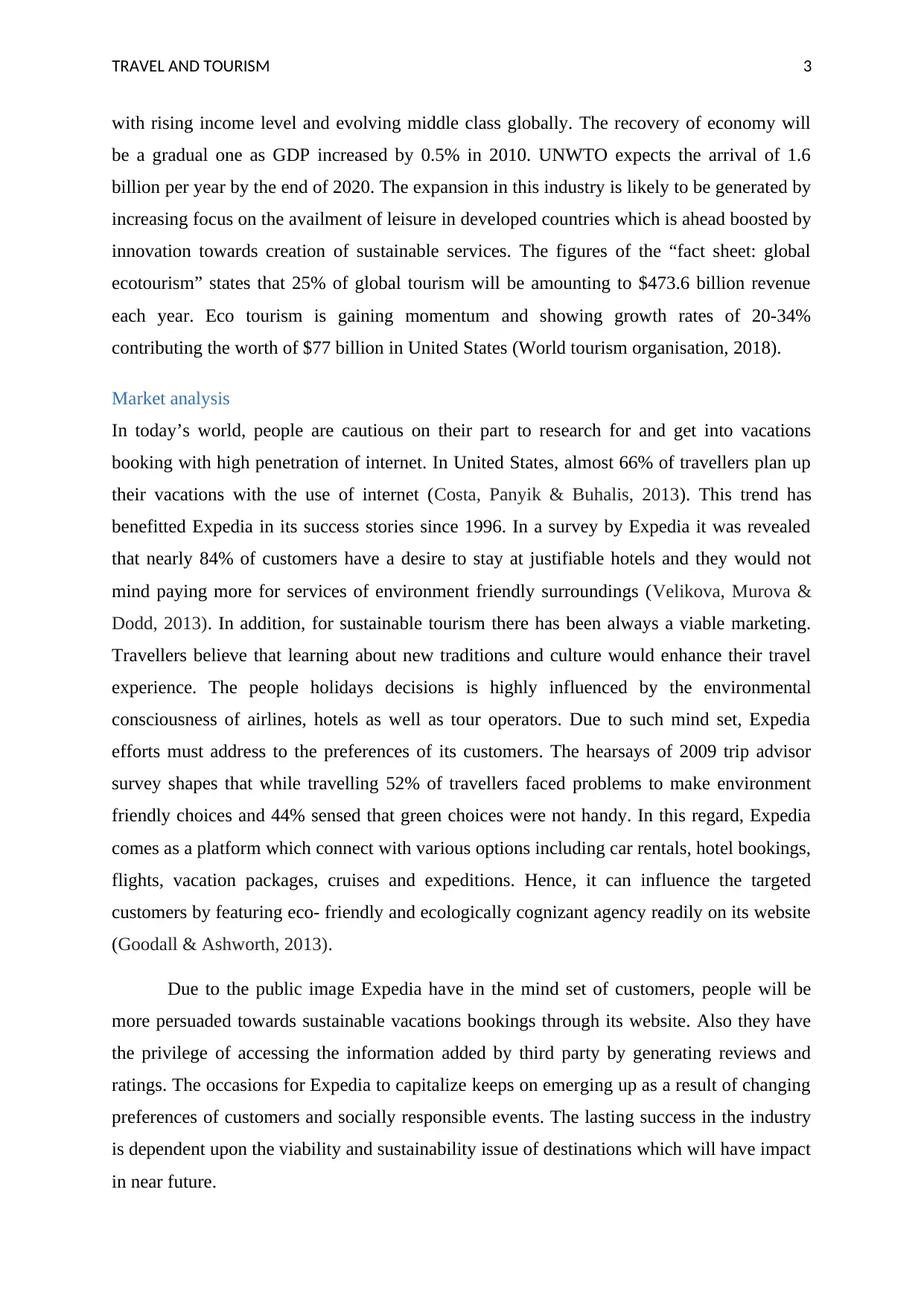
TRAVEL AND TOURISM 3
with rising income level and evolving middle class globally. The recovery of economy will
be a gradual one as GDP increased by 0.5% in 2010. UNWTO expects the arrival of 1.6
billion per year by the end of 2020. The expansion in this industry is likely to be generated by
increasing focus on the availment of leisure in developed countries which is ahead boosted by
innovation towards creation of sustainable services. The figures of the “fact sheet: global
ecotourism” states that 25% of global tourism will be amounting to $473.6 billion revenue
each year. Eco tourism is gaining momentum and showing growth rates of 20-34%
contributing the worth of $77 billion in United States (World tourism organisation, 2018).
Market analysis
In today’s world, people are cautious on their part to research for and get into vacations
booking with high penetration of internet. In United States, almost 66% of travellers plan up
their vacations with the use of internet (Costa, Panyik & Buhalis, 2013). This trend has
benefitted Expedia in its success stories since 1996. In a survey by Expedia it was revealed
that nearly 84% of customers have a desire to stay at justifiable hotels and they would not
mind paying more for services of environment friendly surroundings (Velikova, Murova &
Dodd, 2013). In addition, for sustainable tourism there has been always a viable marketing.
Travellers believe that learning about new traditions and culture would enhance their travel
experience. The people holidays decisions is highly influenced by the environmental
consciousness of airlines, hotels as well as tour operators. Due to such mind set, Expedia
efforts must address to the preferences of its customers. The hearsays of 2009 trip advisor
survey shapes that while travelling 52% of travellers faced problems to make environment
friendly choices and 44% sensed that green choices were not handy. In this regard, Expedia
comes as a platform which connect with various options including car rentals, hotel bookings,
flights, vacation packages, cruises and expeditions. Hence, it can influence the targeted
customers by featuring eco- friendly and ecologically cognizant agency readily on its website
(Goodall & Ashworth, 2013).
Due to the public image Expedia have in the mind set of customers, people will be
more persuaded towards sustainable vacations bookings through its website. Also they have
the privilege of accessing the information added by third party by generating reviews and
ratings. The occasions for Expedia to capitalize keeps on emerging up as a result of changing
preferences of customers and socially responsible events. The lasting success in the industry
is dependent upon the viability and sustainability issue of destinations which will have impact
in near future.
with rising income level and evolving middle class globally. The recovery of economy will
be a gradual one as GDP increased by 0.5% in 2010. UNWTO expects the arrival of 1.6
billion per year by the end of 2020. The expansion in this industry is likely to be generated by
increasing focus on the availment of leisure in developed countries which is ahead boosted by
innovation towards creation of sustainable services. The figures of the “fact sheet: global
ecotourism” states that 25% of global tourism will be amounting to $473.6 billion revenue
each year. Eco tourism is gaining momentum and showing growth rates of 20-34%
contributing the worth of $77 billion in United States (World tourism organisation, 2018).
Market analysis
In today’s world, people are cautious on their part to research for and get into vacations
booking with high penetration of internet. In United States, almost 66% of travellers plan up
their vacations with the use of internet (Costa, Panyik & Buhalis, 2013). This trend has
benefitted Expedia in its success stories since 1996. In a survey by Expedia it was revealed
that nearly 84% of customers have a desire to stay at justifiable hotels and they would not
mind paying more for services of environment friendly surroundings (Velikova, Murova &
Dodd, 2013). In addition, for sustainable tourism there has been always a viable marketing.
Travellers believe that learning about new traditions and culture would enhance their travel
experience. The people holidays decisions is highly influenced by the environmental
consciousness of airlines, hotels as well as tour operators. Due to such mind set, Expedia
efforts must address to the preferences of its customers. The hearsays of 2009 trip advisor
survey shapes that while travelling 52% of travellers faced problems to make environment
friendly choices and 44% sensed that green choices were not handy. In this regard, Expedia
comes as a platform which connect with various options including car rentals, hotel bookings,
flights, vacation packages, cruises and expeditions. Hence, it can influence the targeted
customers by featuring eco- friendly and ecologically cognizant agency readily on its website
(Goodall & Ashworth, 2013).
Due to the public image Expedia have in the mind set of customers, people will be
more persuaded towards sustainable vacations bookings through its website. Also they have
the privilege of accessing the information added by third party by generating reviews and
ratings. The occasions for Expedia to capitalize keeps on emerging up as a result of changing
preferences of customers and socially responsible events. The lasting success in the industry
is dependent upon the viability and sustainability issue of destinations which will have impact
in near future.
Paraphrase This Document
Need a fresh take? Get an instant paraphrase of this document with our AI Paraphraser
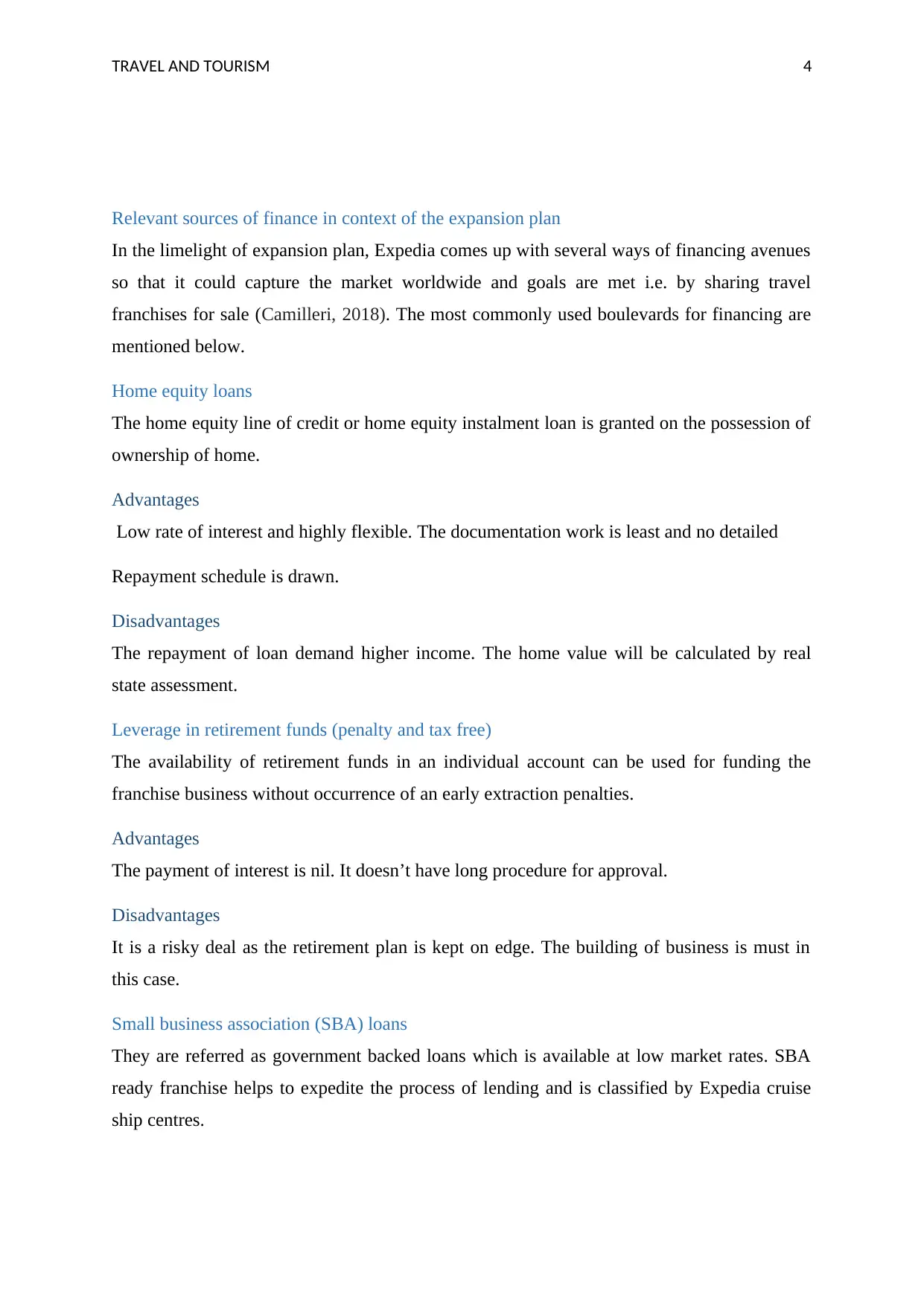
TRAVEL AND TOURISM 4
Relevant sources of finance in context of the expansion plan
In the limelight of expansion plan, Expedia comes up with several ways of financing avenues
so that it could capture the market worldwide and goals are met i.e. by sharing travel
franchises for sale (Camilleri, 2018). The most commonly used boulevards for financing are
mentioned below.
Home equity loans
The home equity line of credit or home equity instalment loan is granted on the possession of
ownership of home.
Advantages
Low rate of interest and highly flexible. The documentation work is least and no detailed
Repayment schedule is drawn.
Disadvantages
The repayment of loan demand higher income. The home value will be calculated by real
state assessment.
Leverage in retirement funds (penalty and tax free)
The availability of retirement funds in an individual account can be used for funding the
franchise business without occurrence of an early extraction penalties.
Advantages
The payment of interest is nil. It doesn’t have long procedure for approval.
Disadvantages
It is a risky deal as the retirement plan is kept on edge. The building of business is must in
this case.
Small business association (SBA) loans
They are referred as government backed loans which is available at low market rates. SBA
ready franchise helps to expedite the process of lending and is classified by Expedia cruise
ship centres.
Relevant sources of finance in context of the expansion plan
In the limelight of expansion plan, Expedia comes up with several ways of financing avenues
so that it could capture the market worldwide and goals are met i.e. by sharing travel
franchises for sale (Camilleri, 2018). The most commonly used boulevards for financing are
mentioned below.
Home equity loans
The home equity line of credit or home equity instalment loan is granted on the possession of
ownership of home.
Advantages
Low rate of interest and highly flexible. The documentation work is least and no detailed
Repayment schedule is drawn.
Disadvantages
The repayment of loan demand higher income. The home value will be calculated by real
state assessment.
Leverage in retirement funds (penalty and tax free)
The availability of retirement funds in an individual account can be used for funding the
franchise business without occurrence of an early extraction penalties.
Advantages
The payment of interest is nil. It doesn’t have long procedure for approval.
Disadvantages
It is a risky deal as the retirement plan is kept on edge. The building of business is must in
this case.
Small business association (SBA) loans
They are referred as government backed loans which is available at low market rates. SBA
ready franchise helps to expedite the process of lending and is classified by Expedia cruise
ship centres.
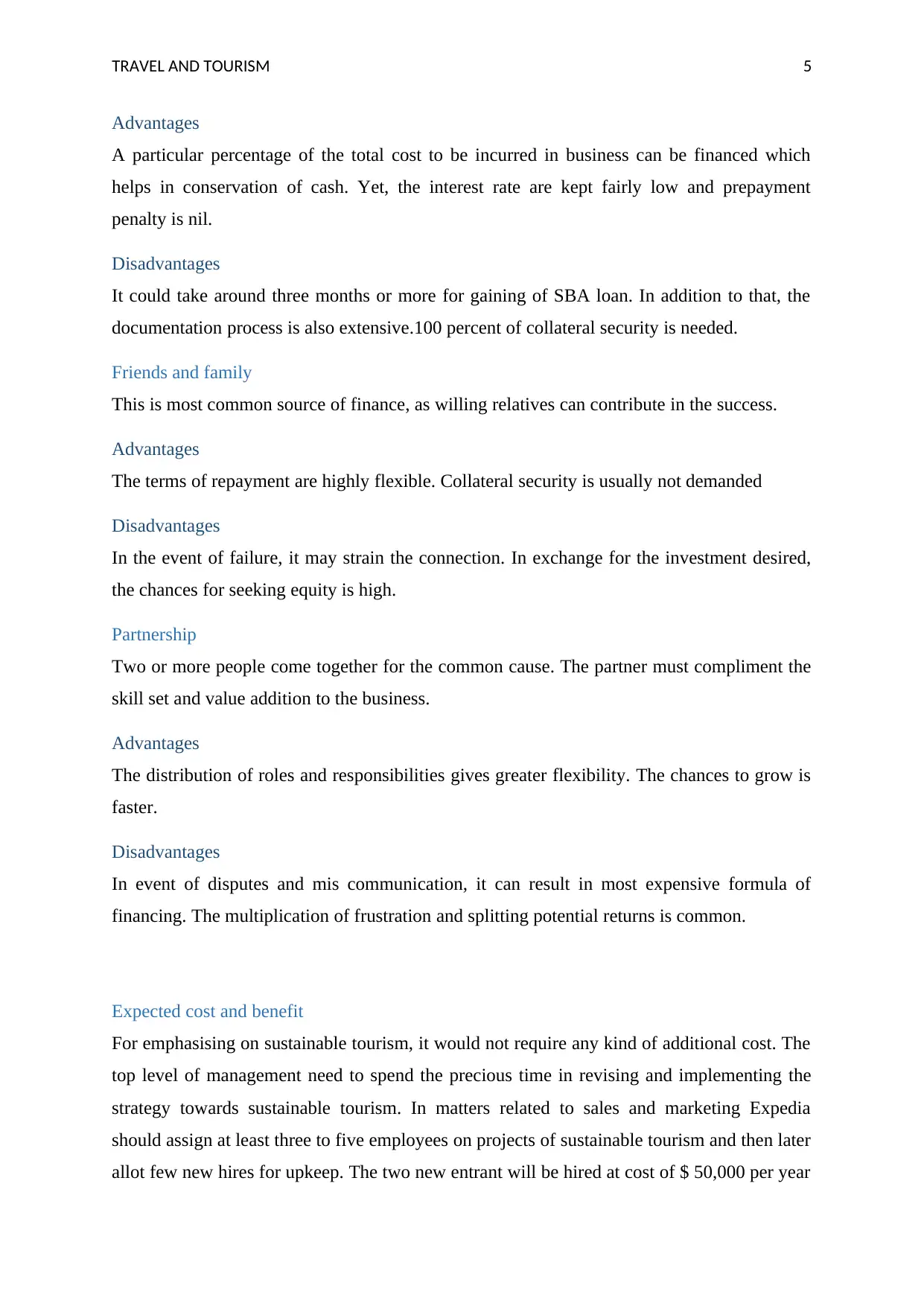
TRAVEL AND TOURISM 5
Advantages
A particular percentage of the total cost to be incurred in business can be financed which
helps in conservation of cash. Yet, the interest rate are kept fairly low and prepayment
penalty is nil.
Disadvantages
It could take around three months or more for gaining of SBA loan. In addition to that, the
documentation process is also extensive.100 percent of collateral security is needed.
Friends and family
This is most common source of finance, as willing relatives can contribute in the success.
Advantages
The terms of repayment are highly flexible. Collateral security is usually not demanded
Disadvantages
In the event of failure, it may strain the connection. In exchange for the investment desired,
the chances for seeking equity is high.
Partnership
Two or more people come together for the common cause. The partner must compliment the
skill set and value addition to the business.
Advantages
The distribution of roles and responsibilities gives greater flexibility. The chances to grow is
faster.
Disadvantages
In event of disputes and mis communication, it can result in most expensive formula of
financing. The multiplication of frustration and splitting potential returns is common.
Expected cost and benefit
For emphasising on sustainable tourism, it would not require any kind of additional cost. The
top level of management need to spend the precious time in revising and implementing the
strategy towards sustainable tourism. In matters related to sales and marketing Expedia
should assign at least three to five employees on projects of sustainable tourism and then later
allot few new hires for upkeep. The two new entrant will be hired at cost of $ 50,000 per year
Advantages
A particular percentage of the total cost to be incurred in business can be financed which
helps in conservation of cash. Yet, the interest rate are kept fairly low and prepayment
penalty is nil.
Disadvantages
It could take around three months or more for gaining of SBA loan. In addition to that, the
documentation process is also extensive.100 percent of collateral security is needed.
Friends and family
This is most common source of finance, as willing relatives can contribute in the success.
Advantages
The terms of repayment are highly flexible. Collateral security is usually not demanded
Disadvantages
In the event of failure, it may strain the connection. In exchange for the investment desired,
the chances for seeking equity is high.
Partnership
Two or more people come together for the common cause. The partner must compliment the
skill set and value addition to the business.
Advantages
The distribution of roles and responsibilities gives greater flexibility. The chances to grow is
faster.
Disadvantages
In event of disputes and mis communication, it can result in most expensive formula of
financing. The multiplication of frustration and splitting potential returns is common.
Expected cost and benefit
For emphasising on sustainable tourism, it would not require any kind of additional cost. The
top level of management need to spend the precious time in revising and implementing the
strategy towards sustainable tourism. In matters related to sales and marketing Expedia
should assign at least three to five employees on projects of sustainable tourism and then later
allot few new hires for upkeep. The two new entrant will be hired at cost of $ 50,000 per year
⊘ This is a preview!⊘
Do you want full access?
Subscribe today to unlock all pages.

Trusted by 1+ million students worldwide
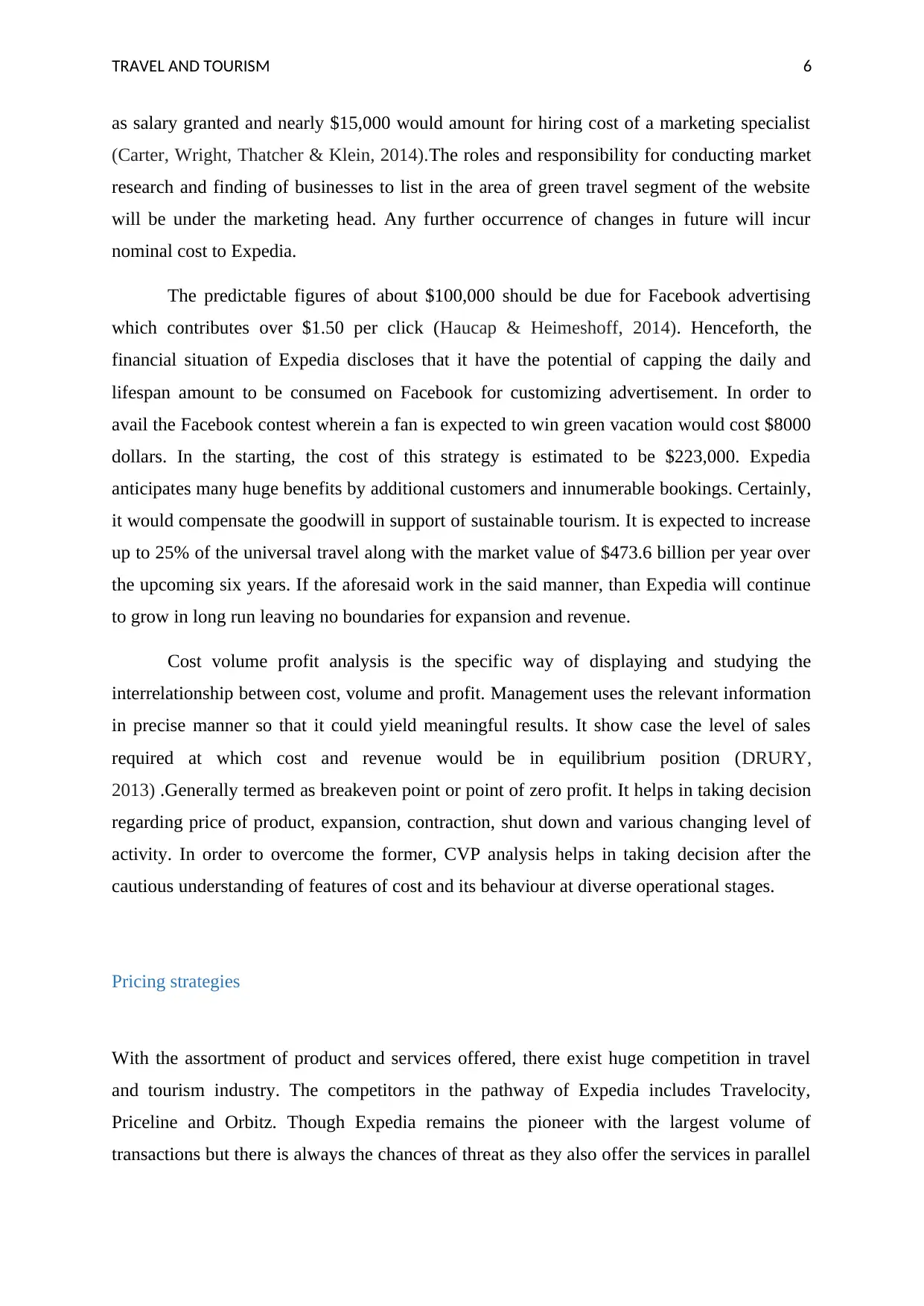
TRAVEL AND TOURISM 6
as salary granted and nearly $15,000 would amount for hiring cost of a marketing specialist
(Carter, Wright, Thatcher & Klein, 2014).The roles and responsibility for conducting market
research and finding of businesses to list in the area of green travel segment of the website
will be under the marketing head. Any further occurrence of changes in future will incur
nominal cost to Expedia.
The predictable figures of about $100,000 should be due for Facebook advertising
which contributes over $1.50 per click (Haucap & Heimeshoff, 2014). Henceforth, the
financial situation of Expedia discloses that it have the potential of capping the daily and
lifespan amount to be consumed on Facebook for customizing advertisement. In order to
avail the Facebook contest wherein a fan is expected to win green vacation would cost $8000
dollars. In the starting, the cost of this strategy is estimated to be $223,000. Expedia
anticipates many huge benefits by additional customers and innumerable bookings. Certainly,
it would compensate the goodwill in support of sustainable tourism. It is expected to increase
up to 25% of the universal travel along with the market value of $473.6 billion per year over
the upcoming six years. If the aforesaid work in the said manner, than Expedia will continue
to grow in long run leaving no boundaries for expansion and revenue.
Cost volume profit analysis is the specific way of displaying and studying the
interrelationship between cost, volume and profit. Management uses the relevant information
in precise manner so that it could yield meaningful results. It show case the level of sales
required at which cost and revenue would be in equilibrium position (DRURY,
2013) .Generally termed as breakeven point or point of zero profit. It helps in taking decision
regarding price of product, expansion, contraction, shut down and various changing level of
activity. In order to overcome the former, CVP analysis helps in taking decision after the
cautious understanding of features of cost and its behaviour at diverse operational stages.
Pricing strategies
With the assortment of product and services offered, there exist huge competition in travel
and tourism industry. The competitors in the pathway of Expedia includes Travelocity,
Priceline and Orbitz. Though Expedia remains the pioneer with the largest volume of
transactions but there is always the chances of threat as they also offer the services in parallel
as salary granted and nearly $15,000 would amount for hiring cost of a marketing specialist
(Carter, Wright, Thatcher & Klein, 2014).The roles and responsibility for conducting market
research and finding of businesses to list in the area of green travel segment of the website
will be under the marketing head. Any further occurrence of changes in future will incur
nominal cost to Expedia.
The predictable figures of about $100,000 should be due for Facebook advertising
which contributes over $1.50 per click (Haucap & Heimeshoff, 2014). Henceforth, the
financial situation of Expedia discloses that it have the potential of capping the daily and
lifespan amount to be consumed on Facebook for customizing advertisement. In order to
avail the Facebook contest wherein a fan is expected to win green vacation would cost $8000
dollars. In the starting, the cost of this strategy is estimated to be $223,000. Expedia
anticipates many huge benefits by additional customers and innumerable bookings. Certainly,
it would compensate the goodwill in support of sustainable tourism. It is expected to increase
up to 25% of the universal travel along with the market value of $473.6 billion per year over
the upcoming six years. If the aforesaid work in the said manner, than Expedia will continue
to grow in long run leaving no boundaries for expansion and revenue.
Cost volume profit analysis is the specific way of displaying and studying the
interrelationship between cost, volume and profit. Management uses the relevant information
in precise manner so that it could yield meaningful results. It show case the level of sales
required at which cost and revenue would be in equilibrium position (DRURY,
2013) .Generally termed as breakeven point or point of zero profit. It helps in taking decision
regarding price of product, expansion, contraction, shut down and various changing level of
activity. In order to overcome the former, CVP analysis helps in taking decision after the
cautious understanding of features of cost and its behaviour at diverse operational stages.
Pricing strategies
With the assortment of product and services offered, there exist huge competition in travel
and tourism industry. The competitors in the pathway of Expedia includes Travelocity,
Priceline and Orbitz. Though Expedia remains the pioneer with the largest volume of
transactions but there is always the chances of threat as they also offer the services in parallel
Paraphrase This Document
Need a fresh take? Get an instant paraphrase of this document with our AI Paraphraser
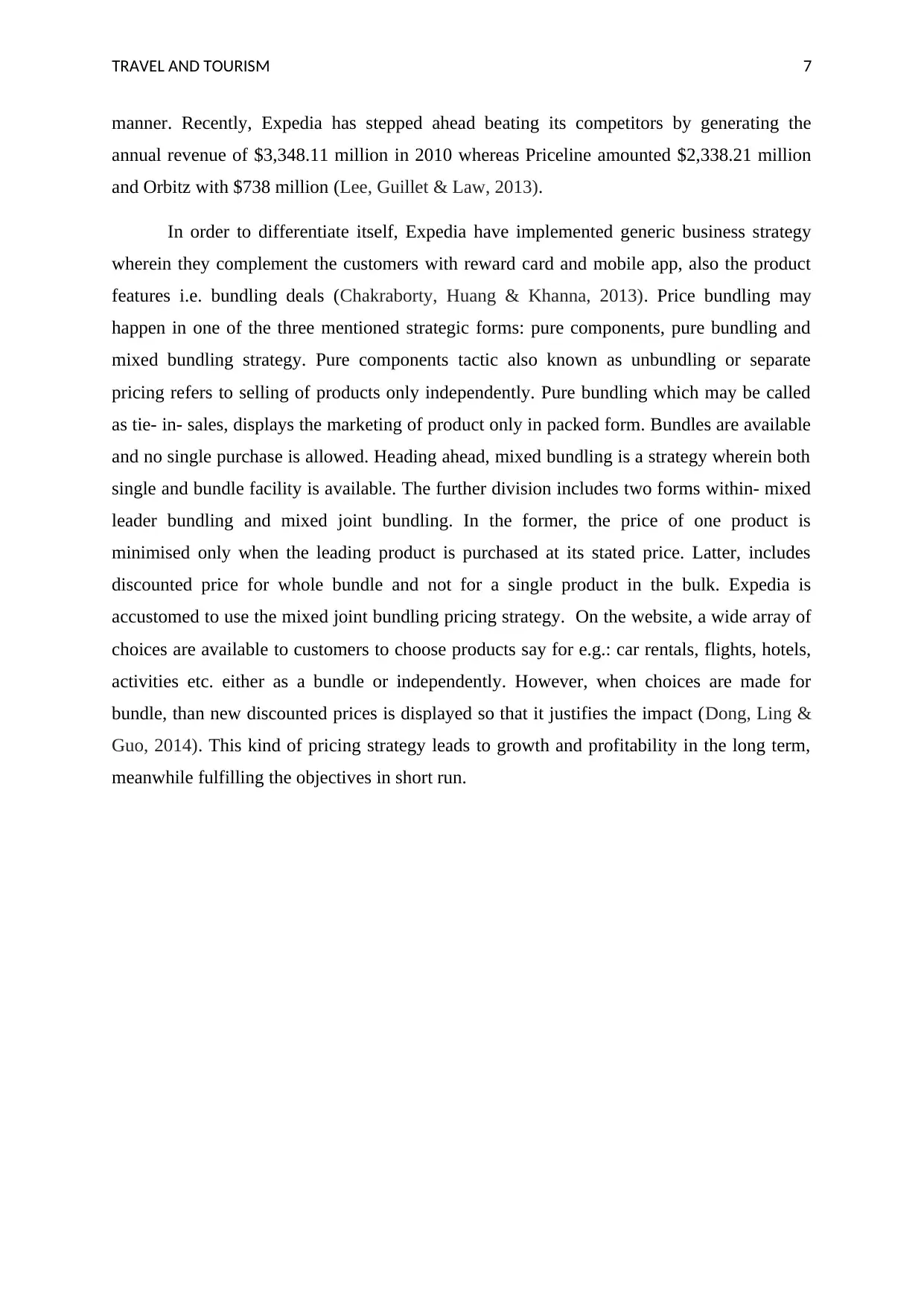
TRAVEL AND TOURISM 7
manner. Recently, Expedia has stepped ahead beating its competitors by generating the
annual revenue of $3,348.11 million in 2010 whereas Priceline amounted $2,338.21 million
and Orbitz with $738 million (Lee, Guillet & Law, 2013).
In order to differentiate itself, Expedia have implemented generic business strategy
wherein they complement the customers with reward card and mobile app, also the product
features i.e. bundling deals (Chakraborty, Huang & Khanna, 2013). Price bundling may
happen in one of the three mentioned strategic forms: pure components, pure bundling and
mixed bundling strategy. Pure components tactic also known as unbundling or separate
pricing refers to selling of products only independently. Pure bundling which may be called
as tie- in- sales, displays the marketing of product only in packed form. Bundles are available
and no single purchase is allowed. Heading ahead, mixed bundling is a strategy wherein both
single and bundle facility is available. The further division includes two forms within- mixed
leader bundling and mixed joint bundling. In the former, the price of one product is
minimised only when the leading product is purchased at its stated price. Latter, includes
discounted price for whole bundle and not for a single product in the bulk. Expedia is
accustomed to use the mixed joint bundling pricing strategy. On the website, a wide array of
choices are available to customers to choose products say for e.g.: car rentals, flights, hotels,
activities etc. either as a bundle or independently. However, when choices are made for
bundle, than new discounted prices is displayed so that it justifies the impact (Dong, Ling &
Guo, 2014). This kind of pricing strategy leads to growth and profitability in the long term,
meanwhile fulfilling the objectives in short run.
manner. Recently, Expedia has stepped ahead beating its competitors by generating the
annual revenue of $3,348.11 million in 2010 whereas Priceline amounted $2,338.21 million
and Orbitz with $738 million (Lee, Guillet & Law, 2013).
In order to differentiate itself, Expedia have implemented generic business strategy
wherein they complement the customers with reward card and mobile app, also the product
features i.e. bundling deals (Chakraborty, Huang & Khanna, 2013). Price bundling may
happen in one of the three mentioned strategic forms: pure components, pure bundling and
mixed bundling strategy. Pure components tactic also known as unbundling or separate
pricing refers to selling of products only independently. Pure bundling which may be called
as tie- in- sales, displays the marketing of product only in packed form. Bundles are available
and no single purchase is allowed. Heading ahead, mixed bundling is a strategy wherein both
single and bundle facility is available. The further division includes two forms within- mixed
leader bundling and mixed joint bundling. In the former, the price of one product is
minimised only when the leading product is purchased at its stated price. Latter, includes
discounted price for whole bundle and not for a single product in the bulk. Expedia is
accustomed to use the mixed joint bundling pricing strategy. On the website, a wide array of
choices are available to customers to choose products say for e.g.: car rentals, flights, hotels,
activities etc. either as a bundle or independently. However, when choices are made for
bundle, than new discounted prices is displayed so that it justifies the impact (Dong, Ling &
Guo, 2014). This kind of pricing strategy leads to growth and profitability in the long term,
meanwhile fulfilling the objectives in short run.
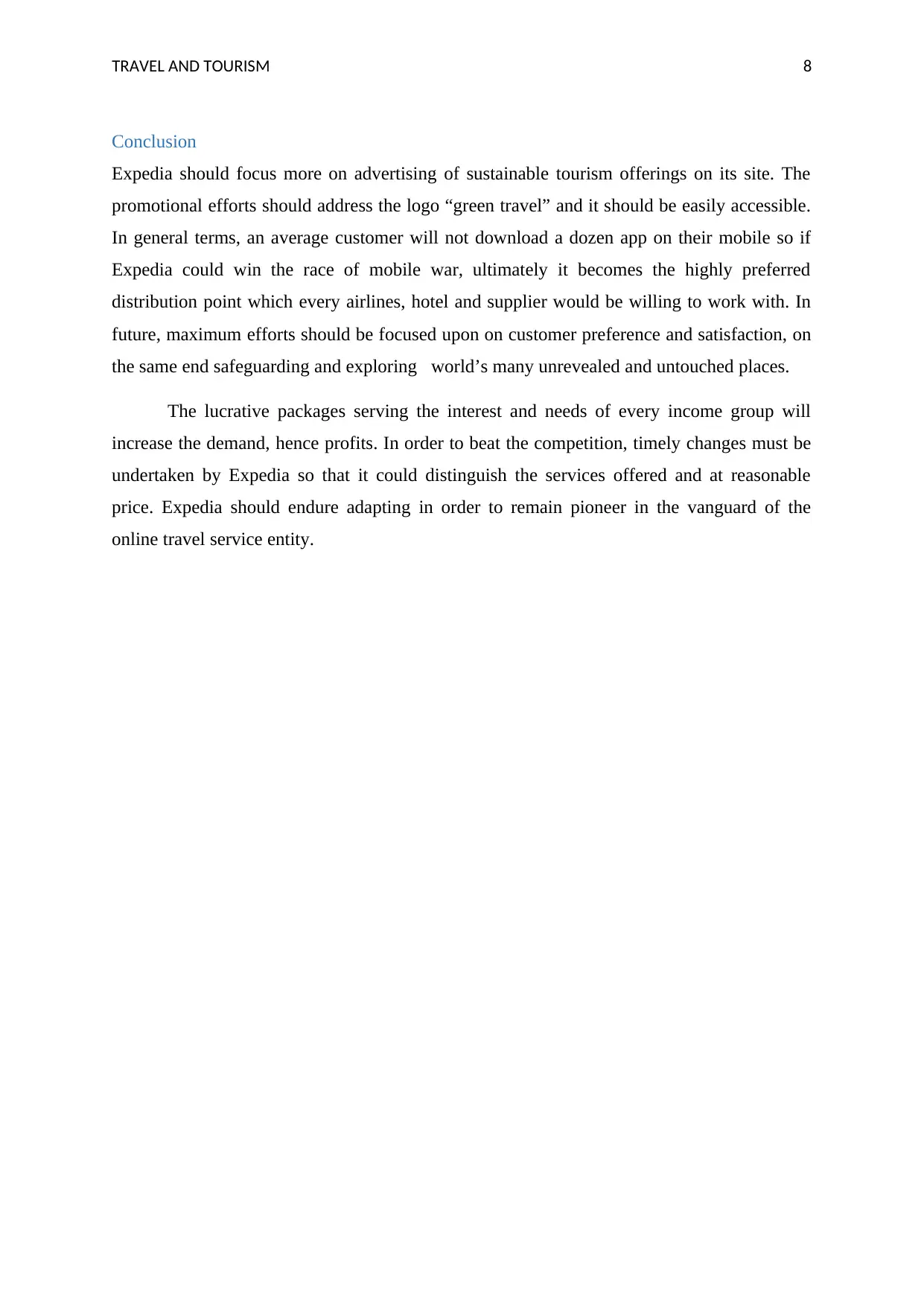
TRAVEL AND TOURISM 8
Conclusion
Expedia should focus more on advertising of sustainable tourism offerings on its site. The
promotional efforts should address the logo “green travel” and it should be easily accessible.
In general terms, an average customer will not download a dozen app on their mobile so if
Expedia could win the race of mobile war, ultimately it becomes the highly preferred
distribution point which every airlines, hotel and supplier would be willing to work with. In
future, maximum efforts should be focused upon on customer preference and satisfaction, on
the same end safeguarding and exploring world’s many unrevealed and untouched places.
The lucrative packages serving the interest and needs of every income group will
increase the demand, hence profits. In order to beat the competition, timely changes must be
undertaken by Expedia so that it could distinguish the services offered and at reasonable
price. Expedia should endure adapting in order to remain pioneer in the vanguard of the
online travel service entity.
Conclusion
Expedia should focus more on advertising of sustainable tourism offerings on its site. The
promotional efforts should address the logo “green travel” and it should be easily accessible.
In general terms, an average customer will not download a dozen app on their mobile so if
Expedia could win the race of mobile war, ultimately it becomes the highly preferred
distribution point which every airlines, hotel and supplier would be willing to work with. In
future, maximum efforts should be focused upon on customer preference and satisfaction, on
the same end safeguarding and exploring world’s many unrevealed and untouched places.
The lucrative packages serving the interest and needs of every income group will
increase the demand, hence profits. In order to beat the competition, timely changes must be
undertaken by Expedia so that it could distinguish the services offered and at reasonable
price. Expedia should endure adapting in order to remain pioneer in the vanguard of the
online travel service entity.
⊘ This is a preview!⊘
Do you want full access?
Subscribe today to unlock all pages.

Trusted by 1+ million students worldwide
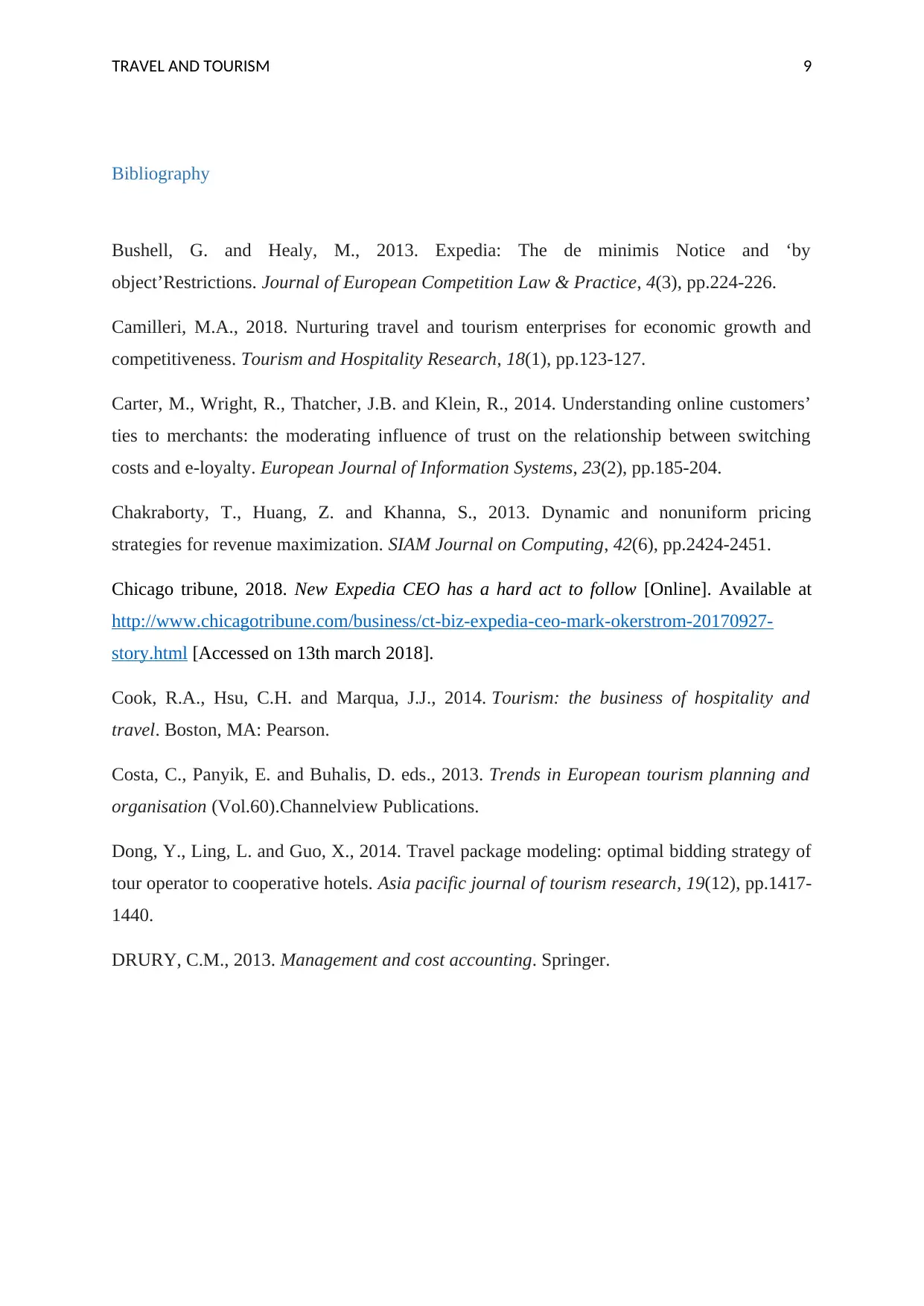
TRAVEL AND TOURISM 9
Bibliography
Bushell, G. and Healy, M., 2013. Expedia: The de minimis Notice and ‘by
object’Restrictions. Journal of European Competition Law & Practice, 4(3), pp.224-226.
Camilleri, M.A., 2018. Nurturing travel and tourism enterprises for economic growth and
competitiveness. Tourism and Hospitality Research, 18(1), pp.123-127.
Carter, M., Wright, R., Thatcher, J.B. and Klein, R., 2014. Understanding online customers’
ties to merchants: the moderating influence of trust on the relationship between switching
costs and e-loyalty. European Journal of Information Systems, 23(2), pp.185-204.
Chakraborty, T., Huang, Z. and Khanna, S., 2013. Dynamic and nonuniform pricing
strategies for revenue maximization. SIAM Journal on Computing, 42(6), pp.2424-2451.
Chicago tribune, 2018. New Expedia CEO has a hard act to follow [Online]. Available at
http://www.chicagotribune.com/business/ct-biz-expedia-ceo-mark-okerstrom-20170927-
story.html [Accessed on 13th march 2018].
Cook, R.A., Hsu, C.H. and Marqua, J.J., 2014. Tourism: the business of hospitality and
travel. Boston, MA: Pearson.
Costa, C., Panyik, E. and Buhalis, D. eds., 2013. Trends in European tourism planning and
organisation (Vol.60).Channelview Publications.
Dong, Y., Ling, L. and Guo, X., 2014. Travel package modeling: optimal bidding strategy of
tour operator to cooperative hotels. Asia pacific journal of tourism research, 19(12), pp.1417-
1440.
DRURY, C.M., 2013. Management and cost accounting. Springer.
Bibliography
Bushell, G. and Healy, M., 2013. Expedia: The de minimis Notice and ‘by
object’Restrictions. Journal of European Competition Law & Practice, 4(3), pp.224-226.
Camilleri, M.A., 2018. Nurturing travel and tourism enterprises for economic growth and
competitiveness. Tourism and Hospitality Research, 18(1), pp.123-127.
Carter, M., Wright, R., Thatcher, J.B. and Klein, R., 2014. Understanding online customers’
ties to merchants: the moderating influence of trust on the relationship between switching
costs and e-loyalty. European Journal of Information Systems, 23(2), pp.185-204.
Chakraborty, T., Huang, Z. and Khanna, S., 2013. Dynamic and nonuniform pricing
strategies for revenue maximization. SIAM Journal on Computing, 42(6), pp.2424-2451.
Chicago tribune, 2018. New Expedia CEO has a hard act to follow [Online]. Available at
http://www.chicagotribune.com/business/ct-biz-expedia-ceo-mark-okerstrom-20170927-
story.html [Accessed on 13th march 2018].
Cook, R.A., Hsu, C.H. and Marqua, J.J., 2014. Tourism: the business of hospitality and
travel. Boston, MA: Pearson.
Costa, C., Panyik, E. and Buhalis, D. eds., 2013. Trends in European tourism planning and
organisation (Vol.60).Channelview Publications.
Dong, Y., Ling, L. and Guo, X., 2014. Travel package modeling: optimal bidding strategy of
tour operator to cooperative hotels. Asia pacific journal of tourism research, 19(12), pp.1417-
1440.
DRURY, C.M., 2013. Management and cost accounting. Springer.
Paraphrase This Document
Need a fresh take? Get an instant paraphrase of this document with our AI Paraphraser
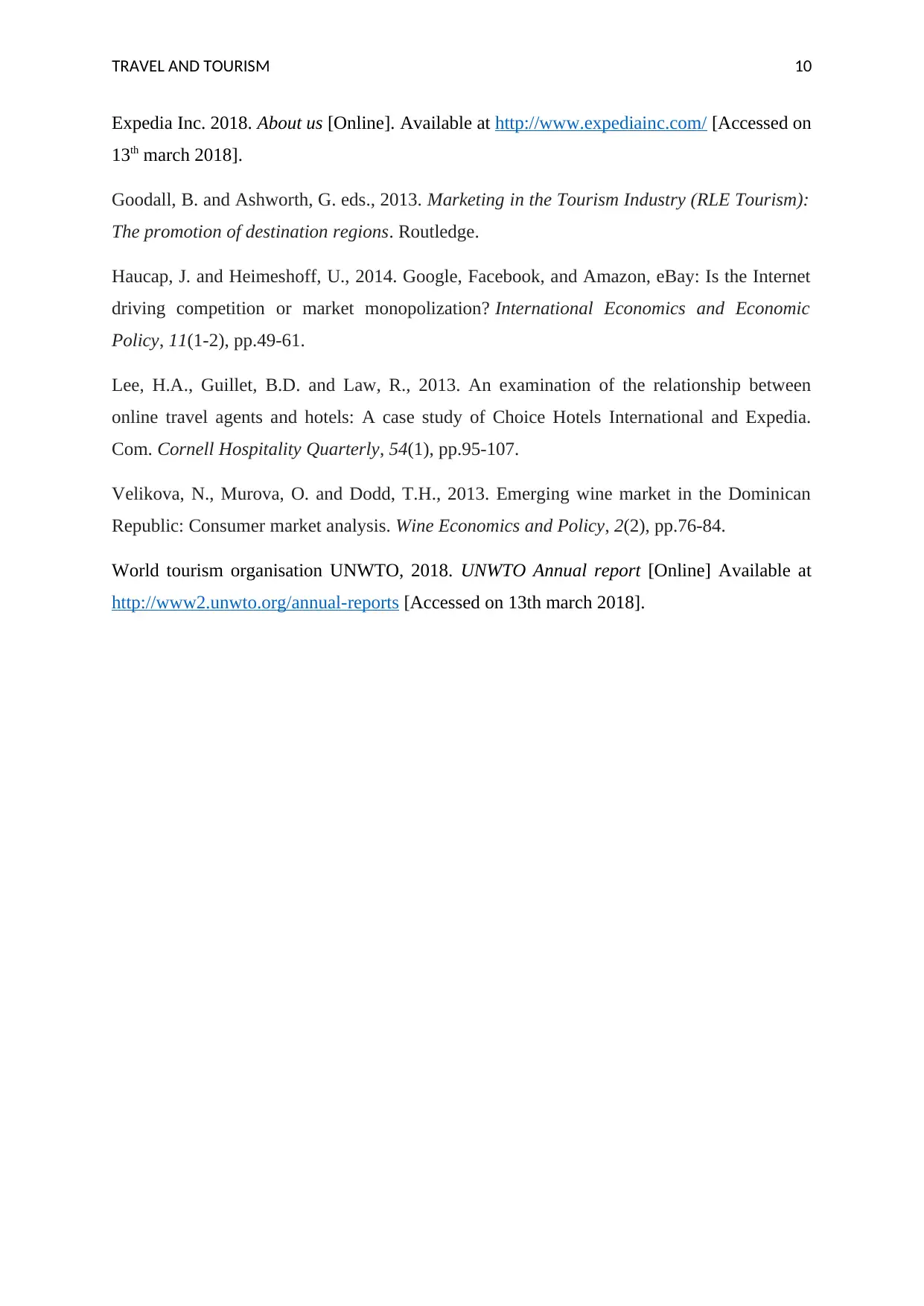
TRAVEL AND TOURISM 10
Expedia Inc. 2018. About us [Online]. Available at http://www.expediainc.com/ [Accessed on
13th march 2018].
Goodall, B. and Ashworth, G. eds., 2013. Marketing in the Tourism Industry (RLE Tourism):
The promotion of destination regions. Routledge.
Haucap, J. and Heimeshoff, U., 2014. Google, Facebook, and Amazon, eBay: Is the Internet
driving competition or market monopolization? International Economics and Economic
Policy, 11(1-2), pp.49-61.
Lee, H.A., Guillet, B.D. and Law, R., 2013. An examination of the relationship between
online travel agents and hotels: A case study of Choice Hotels International and Expedia.
Com. Cornell Hospitality Quarterly, 54(1), pp.95-107.
Velikova, N., Murova, O. and Dodd, T.H., 2013. Emerging wine market in the Dominican
Republic: Consumer market analysis. Wine Economics and Policy, 2(2), pp.76-84.
World tourism organisation UNWTO, 2018. UNWTO Annual report [Online] Available at
http://www2.unwto.org/annual-reports [Accessed on 13th march 2018].
Expedia Inc. 2018. About us [Online]. Available at http://www.expediainc.com/ [Accessed on
13th march 2018].
Goodall, B. and Ashworth, G. eds., 2013. Marketing in the Tourism Industry (RLE Tourism):
The promotion of destination regions. Routledge.
Haucap, J. and Heimeshoff, U., 2014. Google, Facebook, and Amazon, eBay: Is the Internet
driving competition or market monopolization? International Economics and Economic
Policy, 11(1-2), pp.49-61.
Lee, H.A., Guillet, B.D. and Law, R., 2013. An examination of the relationship between
online travel agents and hotels: A case study of Choice Hotels International and Expedia.
Com. Cornell Hospitality Quarterly, 54(1), pp.95-107.
Velikova, N., Murova, O. and Dodd, T.H., 2013. Emerging wine market in the Dominican
Republic: Consumer market analysis. Wine Economics and Policy, 2(2), pp.76-84.
World tourism organisation UNWTO, 2018. UNWTO Annual report [Online] Available at
http://www2.unwto.org/annual-reports [Accessed on 13th march 2018].
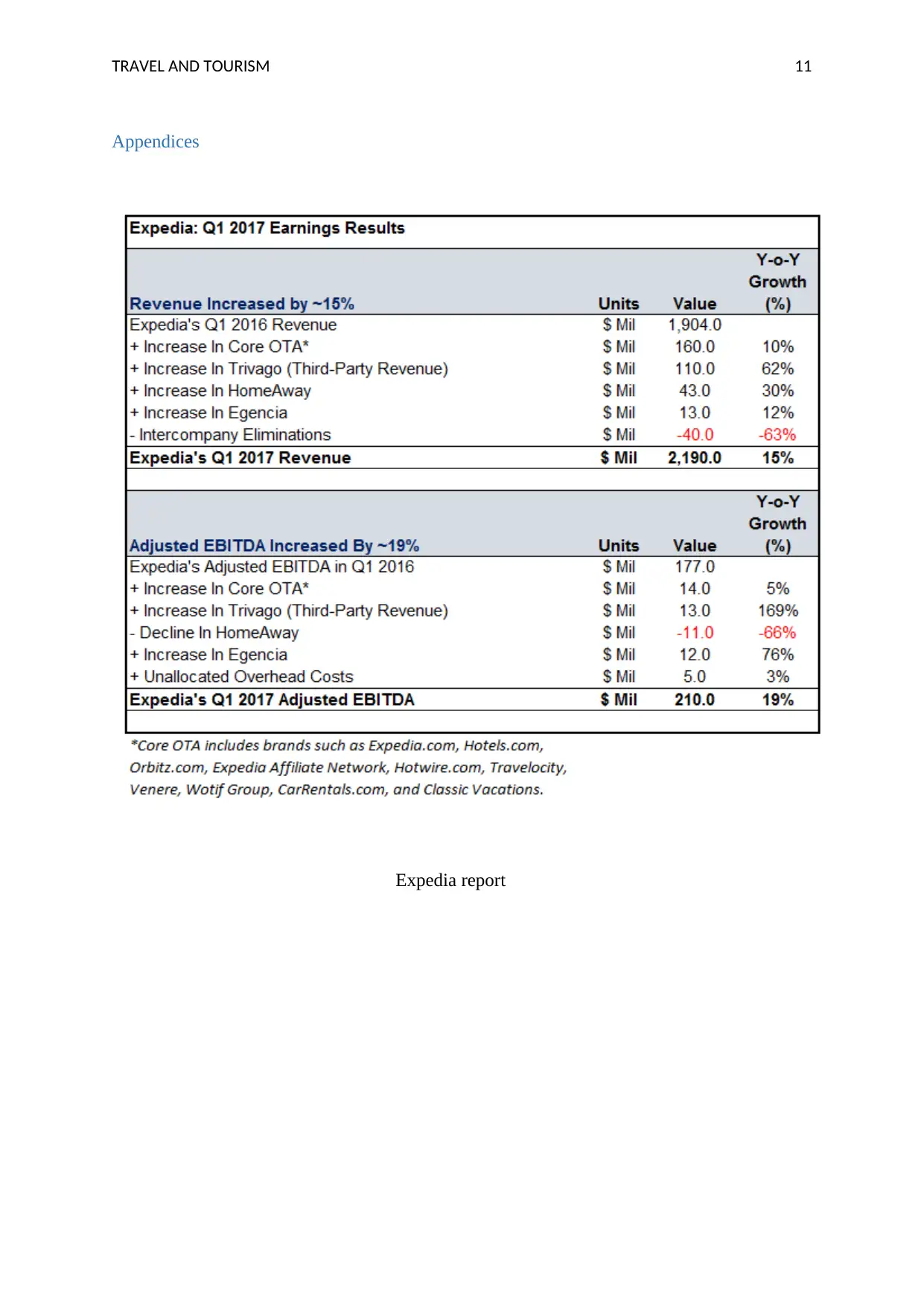
TRAVEL AND TOURISM 11
Appendices
Expedia report
Appendices
Expedia report
⊘ This is a preview!⊘
Do you want full access?
Subscribe today to unlock all pages.

Trusted by 1+ million students worldwide
1 out of 13
Related Documents
Your All-in-One AI-Powered Toolkit for Academic Success.
+13062052269
info@desklib.com
Available 24*7 on WhatsApp / Email
![[object Object]](/_next/static/media/star-bottom.7253800d.svg)
Unlock your academic potential
Copyright © 2020–2025 A2Z Services. All Rights Reserved. Developed and managed by ZUCOL.




